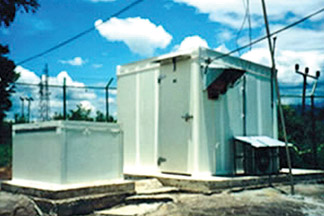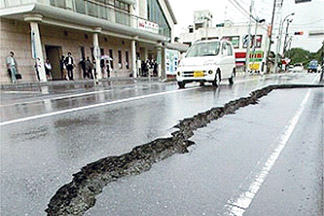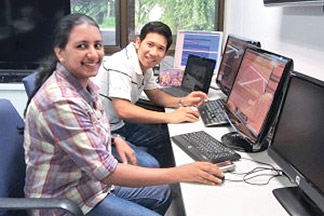|
Earthquakes' awareness vital:
Sri Lanka too figures of late
By Manjula FERNANDO

20,000 people killed in Bhuj earthquake in
Gujarat – Jan 2001

Pallekele Seismic Station

Earthquake cracks

Nilmini Thaldena |

R.M.S.Bandara |

Prof. Kapila Dahanayake |

Sarath Lal Kumara |
The Geological Survey and Mines Bureau says there is no proper study
carried out to conclude for certain that Sri Lanka is becoming
increasingly susceptible to devastating earthquakes.
A spate of recent tremors felt in Sri Lanka has roused suspicion if
the country is getting increasingly vulnerable to earthquakes but
Nilmini Thaldena of Geological Survey and Mines Bureau (GSMB) said the
research in this sector had been very poor to give the geologists a
clear idea as to where we were heading. Only findings of in depth
studies will reveal whether there has been a change in pattern of earth
tremors or not.
There has been increased awareness lately and we have acquired the
technology to measure earthquakes since 2000. This is one reason every
minor tremor that Sri Lanka feel is being recorded and reported.
It does not imply that there is a heightened threat. "But we have to
investigate", she said.
On the other hand the number of earth tremors worldwide has indeed
increased, in this backdrop we could surmise that the tremors felt
within Sri Lankan region could also have risen. But this needs to be
verified with proper data, she said.
During the construction of Kothmale reservoir in the 1980s, the
project engineers had observed a 2.5 point earth tremor. This indicates
that there has always been minor tremors in our region but the proper
technology to measure them in Sri Lanka was absent until the recent
past.
The first seismometer in Pallekelle was set up in 2000 by the
California university as part of their global earthquake monitoring
network, then in 2010 two more centres were set up in Hakmana (Galle)
and Anuradhapura as part of a German tsunami early warning network. All
three stations are with modern technology and help Sri Lankan geologists
to make fairly accurate readings in the domestic front.
"From the data gathered so far, we believe Sri Lanka is affected by
one minor earth tremor every 1-2 years."
However this year this pattern was broken, there were three tremors
close on the heels of each other. The first was on April 11, 2012 at
2.08pm followed by an after shock at 4.13pm. It was felt by almost all
parts of the country. US Geological Survey said this was due to an
undersea earthquake near the Sumatra region.
The second was on May 20, 2012. This particular earthquake originated
within the country unlike the former. The GSMB estimated the epicentre
of this earth tremor that recorded 3.6 points in the Richter scale to be
in the lower slopes of the central hills.
The third one was recorded on May 26 at 9.52am. It was felt in the
east, west, south and northern parts of the country. This too has
originated within the country.
Thaldena said if Sri Lanka could acquire at least four more stations,
it will help them find the precise location of the epicentre if the
tremor originated within the country and a more accurate reading on the
strength of the tremor.
The GSMB is in the process of setting up four new stations covering
the west and the north of the country. They are currently trying to find
sponsors for the new stations that are estimated to cost Rs.120 million
in total.
Although it has not been established if there is a probability Sri
Lanka is getting more vulnerable, it is necessary to review the
resistance of the existing high rise buildings in highly populated areas
to prevent large-scale human casualties in the event of an earthquake,
R.M.S.Bandara, Head Landslides of the National Building Research
Organisation (NBRO), said. "Sri Lanka so far has no building code
concerning earth tremors."
"We need to seriously think about the way how the future buildings,
especially the multi story structures should be designed to resist
powerful earth tremors."
He said the Disaster Management Centre has appointed a committee
comprising officers representing the NBRO, CEB and University professors
to research and report on the future prospects for Sri Lanka.
It is reported that the Twin Towers, Jaic Hilton and the Bank of
Ceylon tower have been designed in line with seismic building codes but
there is no clear information as to the other buildings within Colombo.
Designing a building code requires a proper study on earth tremors
reaching Sri Lanka as well as the geological make up of the vulnerable
areas. How the waves originating from different epicentres/ earthquake
locations - Indonesia, Australia or South Africa, etc - reach the
country is another important data when designing seismic building codes.
Bandara said the Urban Development Authority which currently gives
clearance to building plans could oversee the adherence to the building
code. However, how long this process will take to put in place a proper
building code is unclear.
"We could study the building codes in Japan or India but our model
has to be unique to geological and other aspects in Sri Lanka."
The earthquake resistant buildings have special foundations, and
other structural modifications to withstand vibrations caused by an
earth tremor. The modifications vary based on the extent of the land and
number of stories of the proposed building, etc.
In Japan, a country always affected by devastating earthquakes, a
mini model of the new structure is always tested on a special 'testing
table' before a construction is given the green light. If the structure
develops cracks during the test, it will be perfected with more
modifications to the original plan.
The Disaster Management Centre Spokesperson Sarath Lal Kumara said, a
workshop of all stakeholders last week at the National Science
Foundation discussed that universities should be encouraged to carry out
studies to ascertain if Sri Lanka had a serious threat in the future
with earthquakes. The meeting chaired by Disaster Management Minister
Mahinda Amaraweera was attended by senior officials from GSMB, NBRO, Met
Department, all the stake-holders.
It has also been highlighted the urgent need to make people aware on
how to react in an earthquake. Minister Amaraweera was quoted as saying
"May be we are driven by unfounded fear but earthquakes are something
that we cannot afford to ignore for the consequences could be
devastating."
Former Head of Peradeniya University's Geology Department Prof.
Kapila Dahanayake said there was no need for new plate formations near
Sri Lanka to make the country vulnerable to earth tremors. Earthquakes
can occur anywhere anytime. Therefore preparedness is very vital. The
earthquakes mostly occur in the tectonic plate boundaries. But Sri Lanka
is also affected by intra plate tremors which are not a very common
occurrence, he said.
A few years ago in Bhuj, India (Gujarat) thousands of people died due
to an intra plate earthquake. Since 1960s there have been more than 60
reported earth tremors in Sri Lanka. "It is true that new plate
formation is observed near Sri Lanka. But this could take another 100
million years to complete. There was a devastating earthquake in 1615 in
Sri Lanka, long before the new plate formation was reported. In
geological years few hundred years is like yesterday. So we cannot say
the 1615 earthquake is too far in the history to get repeated."
"An indepth study may sometimes show that this is not at all a new
phenomenon, that there is no new or heightened threat for Sri Lanka but
it is a risk that we cannot take when dealing with earthquakes," he
added.
Prof. Dahanayake highlighted the urgency to create awareness among
the masses, and school-children on how to react in an earthquake
situation. |

